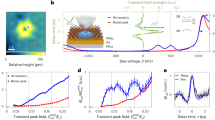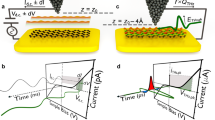Abstract
The electronic and optical properties of van der Waals heterostructures are strongly influenced by the structuration and homogeneity of their nano- and atomic-scale environments. Unravelling this intimate structure–property relationship is a key challenge that requires methods capable of addressing the light–matter interactions in van der Waals materials with ultimate spatial resolution. Here we use a low-temperature scanning tunnelling microscope to probe—with atomic-scale resolution—the excitonic luminescence of a van der Waals heterostructure, made of a transition metal dichalcogenide monolayer stacked onto a few-layer graphene flake supported by a Au(111) substrate. Sharp emission lines arising from neutral, charged and localized excitons are reported. Their intensities and emission energies vary as a function of the nanoscale topography of the van der Waals heterostructure, explaining the variability of the emission properties observed with diffraction-limited approaches. Our work paves the way towards understanding and controlling optoelectronic phenomena in moiré superlattices with atomic-scale resolution.
This is a preview of subscription content, access via your institution
Access options
Access Nature and 54 other Nature Portfolio journals
Get Nature+, our best-value online-access subscription
$29.99 / 30 days
cancel any time
Subscribe to this journal
Receive 12 print issues and online access
$259.00 per year
only $21.58 per issue
Buy this article
- Purchase on Springer Link
- Instant access to full article PDF
Prices may be subject to local taxes which are calculated during checkout




Similar content being viewed by others
Data availability
Source data necessary to reproduce the results shown in the Article and Supplementary Information are available via figshare at https://doi.org/10.6084/m9.figshare.21913017. Additional data are available from the corresponding authors upon reasonable request. Source data are provided with this paper.
References
Wang, G. et al. Colloquium: excitons in atomically thin transition metal dichalcogenides. Rev. Mod. Phys. 90, 021001 (2018).
Mak, K. F. & Shan, J. Photonics and optoelectronics of 2D semiconductor transition metal dichalcogenides. Nat. Photon. 10, 216–226 (2016).
Shree, S., Paradisanos, I., Marie, X., Robert, C. & Urbaszek, B. Guide to optical spectroscopy of layered semiconductors. Nat. Rev. Phys. 3, 39–54 (2021).
Harats, M. G., Kirchhof, J. N., Qiao, M., Greben, K. & Bolotin, K. I. Dynamics and efficient conversion of excitons to trions in non-uniformly strained monolayer WS2. Nat. Photon. 14, 324–329 (2020).
Raja, A. et al. Dielectric disorder in two-dimensional materials. Nat. Nanotechnol. 14, 832–837 (2019).
Chow, P. K. et al. Defect-induced photoluminescence in monolayer semiconducting transition metal dichalcogenides. ACS Nano 9, 1520–1527 (2015).
Tongay, S. et al. Broad-range modulation of light emission in two-dimensional semiconductors by molecular physisorption gating. Nano Lett. 13, 2831–2836 (2013).
Wilson, N. P., Yao, W., Shan, J. & Xu, X. Excitons and emergent quantum phenomena in stacked 2D semiconductors. Nature 599, 383–392 (2021).
Yu, H., Liu, G.-B., Tang, J., Xu, X. & Yao, W. Moiré excitons: from programmable quantum emitter arrays to spin–orbit–coupled artificial lattices. Sci. Adv. 3, e1701696 (2017).
Pommier, D. et al. Scanning tunneling microscope-induced excitonic luminescence of a two-dimensional semiconductor. Phys. Rev. Lett. 123, 027402 (2019).
Darlington, T. P. et al. Imaging strain-localized excitons in nanoscale bubbles of monolayer WSe2 at room temperature. Nat. Nanotechnol. 15, 854–860 (2020).
Bonnet, N. et al. Nanoscale modification of WS2 trion emission by its local electromagnetic environment. Nano Lett. 21, 10178–10185 (2021).
Péchou, R. et al. Plasmonic-induced luminescence of MoSe2 monolayers in a scanning tunneling microscope. ACS Photonics 7, 3061–3070 (2020).
Peña Román, R. J. et al. Tunneling-current-induced local excitonic luminescence in p-doped WSe2 monolayers. Nanoscale 12, 13460–13470 (2020).
Zhang, S. et al. Nano-spectroscopy of excitons in atomically thin transition metal dichalcogenides. Nat. Commun. 13, 542 (2022).
Peña Román, R. J. et al. Tip-induced and electrical control of the photoluminescence yield of monolayer WS2. Nano Lett. 22, 9244–9251 (2022).
Qiu, X. H., Nazin, G. V. & Ho, W. Vibrationally resolved fluorescence excited with submolecular precision. Science 299, 542–546 (2003).
Zhang, Y. et al. Visualizing coherent intermolecular dipole–dipole coupling in real space. Nature 531, 623–627 (2016).
Doppagne, B. et al. Vibronic spectroscopy with submolecular resolution from STM-induced electroluminescence. Phys. Rev. Lett. 118, 127401 (2017).
Imada, H. et al. Real-space investigation of energy transfer in heterogeneous molecular dimers. Nature 538, 364–367 (2016).
Krane, N., Lotze, C., Lager, J. M., Reecht, G. & Franke, K. J. Electronic structure and luminescence of quasi-freestanding MoS2 nanopatches on Au(111). Nano Lett. 16, 5163–5168 (2016).
Schuler, B. et al. Electrically driven photon emission from individual atomic defects in monolayer WS2. Sci. Adv. 6, eabb5988 (2020).
Velický, M. et al. Strain and charge doping fingerprints of the strong interaction between monolayer MoS2 and gold. J. Phys. Chem. Lett. 11, 6112–6118 (2020).
Castellanos-Gomez, A. et al. Deterministic transfer of two-dimensional materials by all-dry viscoelastic stamping. 2D Mater. 1, 011002 (2014).
Cadiz, F. et al. Excitonic linewidth approaching the homogeneous limit in MoS2-based van der Waals heterostructures. Phys. Rev. X 7, 021026 (2017).
Rosławska, A. et al. Mapping Lamb, Stark, and Purcell effects at a chromophore-picocavity junction with hyper-resolved fluorescence microscopy. Phys. Rev. X 12, 011012 (2022).
Ross, J. S. et al. Electrical control of neutral and charged excitons in a monolayer semiconductor. Nat. Commun. 4, 1474 (2013).
Branny, A. et al. Discrete quantum dot like emitters in monolayer MoSe2: spatial mapping, magneto-optics, and charge tuning. Appl. Phys. Lett. 108, 142101 (2016).
Lorchat, E. et al. Filtering the photoluminescence spectra of atomically thin semiconductors with graphene. Nat. Nanotechnol. 15, 283–288 (2020).
Parra López, L. E. et al. Single- and narrow-line photoluminescence in a boron nitride-supported MoSe2/graphene heterostructure. C. R. Phys. 22, 77–88 (2021).
Wu, S. W., Nazin, G. V. & Ho, W. Intramolecular photon emission from a single molecule in a scanning tunneling microscope. Phys. Rev. B 77, 205430 (2008).
Robert, C. et al. Exciton radiative lifetime in transition metal dichalcogenide monolayers. Phys. Rev. B 93, 205423 (2016).
Srivastava, A. et al. Optically active quantum dots in monolayer WSe2. Nat. Nanotechnol. 10, 491–496 (2015).
He, Y.-M. et al. Single quantum emitters in monolayer semiconductors. Nat. Nanotechnol. 10, 497–502 (2015).
Koperski, M. et al. Single photon emitters in exfoliated WSe2 structures. Nat. Nanotechnol. 10, 503–506 (2015).
Chakraborty, C., Kinnischtzke, L., Goodfellow, K. M., Beams, R. & Vamivakas, A. N. Voltage-controlled quantum light from an atomically thin semiconductor. Nat. Nanotechnol. 10, 507–511 (2015).
Tonndorf, P. et al. Single-photon emission from localized excitons in an atomically thin semiconductor. Optica 2, 347–352 (2015).
Hill, H. M. et al. Exciton broadening in WS2/graphene heterostructures. Phys. Rev. B 96, 205401 (2017).
Goryca, M. et al. Revealing exciton masses and dielectric properties of monolayer semiconductors with high magnetic fields. Nat. Commun. 10, 4172 (2019).
Raja, A. et al. Coulomb engineering of the bandgap and excitons in two-dimensional materials. Nat. Commun. 8, 15251 (2017).
Froehlicher, G., Lorchat, E. & Berciaud, S. Charge versus energy transfer in atomically thin graphene-transition metal dichalcogenide van der Waals heterostructures. Phys. Rev. X 8, 011007 (2018).
Ugeda, M. M. et al. Giant bandgap renormalization and excitonic effects in a monolayer transition metal dichalcogenide semiconductor. Nat. Mater. 13, 1091–1095 (2014).
Zhang, C. et al. Probing critical point energies of transition metal dichalcogenides: surprising indirect gap of single layer WSe2. Nano Lett. 15, 6494–6500 (2015).
Miwa, K. et al. Many-body state description of single-molecule electroluminescence driven by a scanning tunneling microscope. Nano Lett. 19, 2803–2811 (2019).
Doležal, J., Canola, S., Merino, P. & Švec, M. Exciton-trion conversion dynamics in a single molecule. ACS Nano 15, 7694–7699 (2021).
Kulig, M. et al. Exciton diffusion and halo effects in monolayer semiconductors. Phys. Rev. Lett. 120, 207401 (2018).
Huang, B. et al. Emergent phenomena and proximity effects in two-dimensional magnets and heterostructures. Nat. Mater. 19, 1276–1289 (2020).
Tang, Y. et al. Simulation of Hubbard model physics in WSe2/WS2 moiré superlattices. Nature 579, 353–358 (2020).
Li, H. et al. Imaging two-dimensional generalized Wigner crystals. Nature 597, 650–654 (2021).
Seyler, K. L. et al. Signatures of moiré-trapped valley excitons in MoSe2/WSe2 heterobilayers. Nature 567, 66–70 (2019).
Baek, H. et al. Highly energy-tunable quantum light from moiré-trapped excitons. Sci. Adv. 6, eaba8526 (2020).
Liu, E. et al. Signatures of moiré trions in WSe2/MoSe2 heterobilayers. Nature 594, 46–50 (2021).
Imada, H. et al. Single-molecule laser nanospectroscopy with micro-electron volt energy resolution. Science 373, 95–98 (2021).
Acknowledgements
We thank M. Chong, B. Doppagne, G. Froehlicher, A. Gloppe, E. Le Moal, E. Lorchat and T. Neuman for fruitful discussions. We are grateful to the IPCMS mechanical workshop, particularly H. Sumar, as well as V. Speisser, M. Romeo and the STnano cleanroom staff for technical support. This project has received funding from the European Research Council (ERC) under the European Union’s Horizon 2020 research and innovation programme (grant agreement no. 771850) and the European Union’s Horizon 2020 research and innovation programme under the Marie Skłodowska-Curie grant agreement no. 894434. We acknowledge financial support from the Agence Nationale de la Recherche under grant ATOEMS ANR-20-CE24-0010. This work of the Interdisciplinary Thematic Institute QMat, as part of the ITI 2021 2028 program of the University of Strasbourg, CNRS and Inserm, was supported by IdEx Unistra (ANR 10 IDEX 0002), as well as by SFRI STRAT’US project (ANR 20 SFRI 0012) and EUR QMAT ANR-17-EURE-0024 under the framework of the French Investments for the Future Program. S.B. acknowledges support from the Indo-French Centre for the Promotion of Advanced Research (CEFIPRA) and from the Institut Universitaire de France (IUF).
Author information
Authors and Affiliations
Contributions
S.B. and G.S. initiated and supervised the project. L.E.P.L., A.R., F.S. and G.S. built the STML setup. L.E.P.L. fabricated the sample and performed all the PL and STML measurements, with input from A.R., S.B. and G.S. L.E.P.L., S.B. and G.S. analysed the experimental data. All the authors discussed the results and contributed to the editing of the paper.
Corresponding authors
Ethics declarations
Competing interests
The authors declare no competing interests.
Peer review
Peer review information
Nature Materials thanks Libai Huang, Lukas Novotny and the other, anonymous, reviewer(s) for their contribution to the peer review of this work.
Additional information
Publisher’s note Springer Nature remains neutral with regard to jurisdictional claims in published maps and institutional affiliations.
Supplementary information
Supplementary Information
Supplementary Figs. 1–4 and Sections 1–4.
Supplementary Data 1
Source data for Supplementary Fig. 2.
Supplementary Data 2
Source data for Supplementary Fig. 3.
Supplementary Data 3
Source data for Supplementary Fig. 4.
Source data
Source Data Fig. 1
Source data for Fig. 1.
Source Data Fig. 2
Source data for Fig. 2.
Source Data Fig. 3
Source data for Fig. 3.
Source Data Fig. 4
Source data for Fig. 4.
Rights and permissions
Springer Nature or its licensor (e.g. a society or other partner) holds exclusive rights to this article under a publishing agreement with the author(s) or other rightsholder(s); author self-archiving of the accepted manuscript version of this article is solely governed by the terms of such publishing agreement and applicable law.
About this article
Cite this article
López, L.E.P., Rosławska, A., Scheurer, F. et al. Tip-induced excitonic luminescence nanoscopy of an atomically resolved van der Waals heterostructure. Nat. Mater. 22, 482–488 (2023). https://doi.org/10.1038/s41563-023-01494-4
Received:
Accepted:
Published:
Issue Date:
DOI: https://doi.org/10.1038/s41563-023-01494-4
This article is cited by
-
Tunnelling electrons locally ignite excitons
Nature Materials (2023)
-
Genetic descriptor search algorithm for predicting hydrogen adsorption free energy of 2D material
Scientific Reports (2023)



